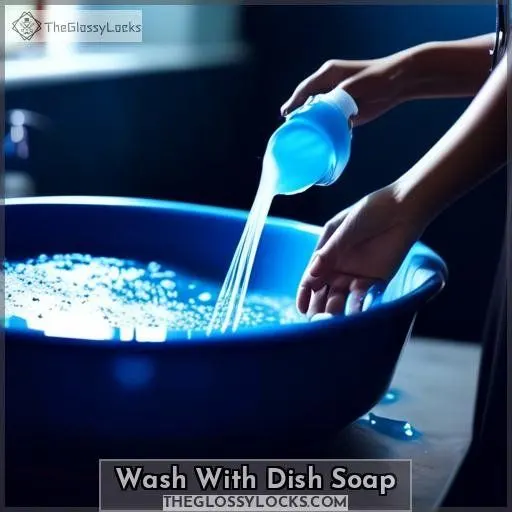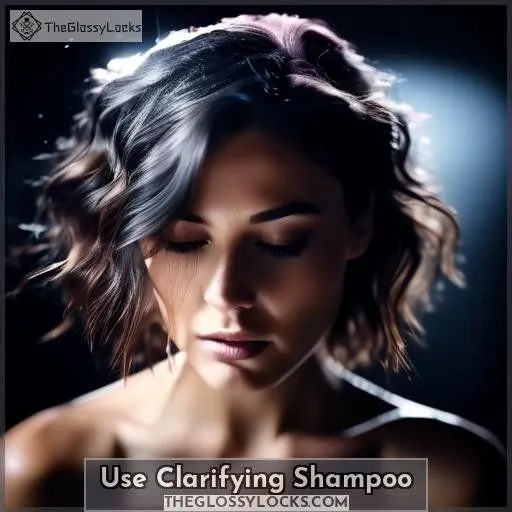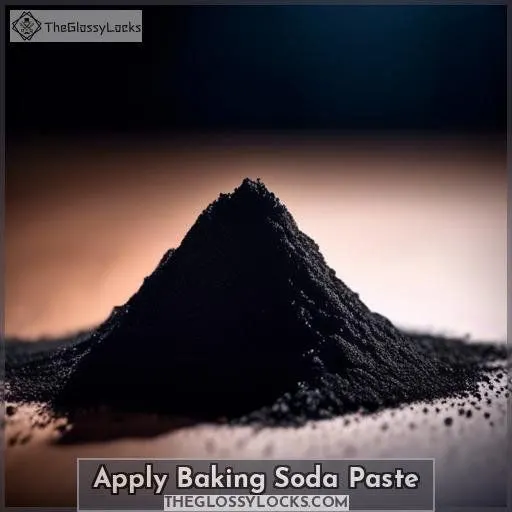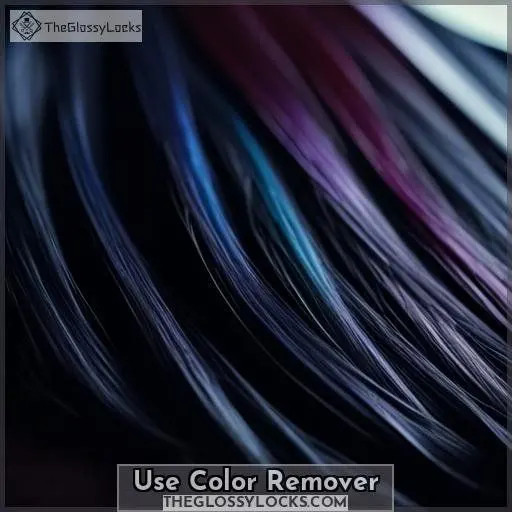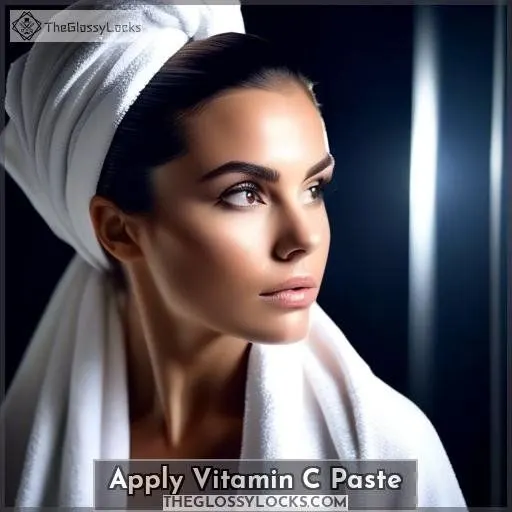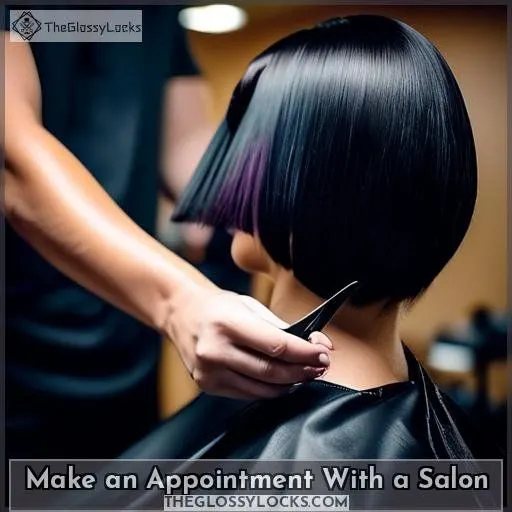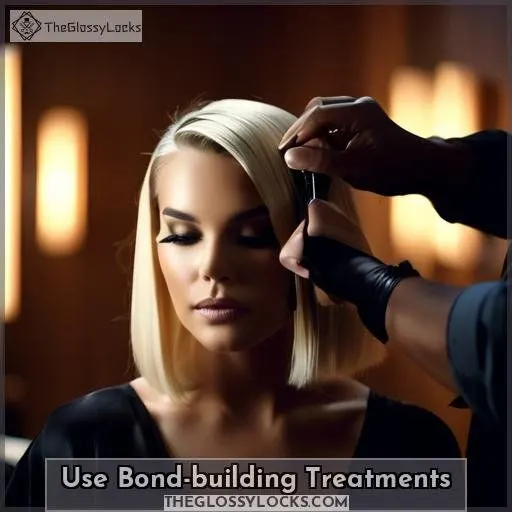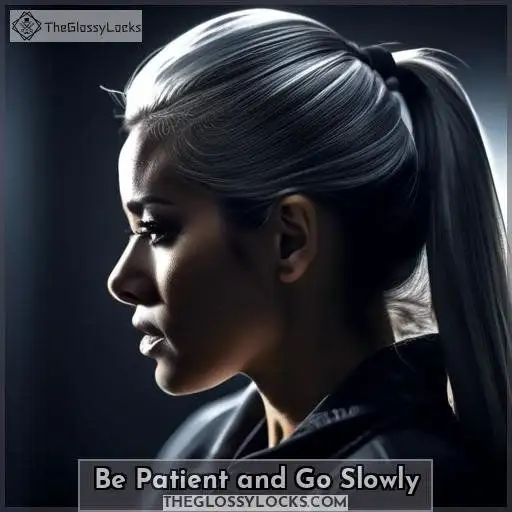This site is supported by our readers. We may earn a commission, at no cost to you, if you purchase through links.
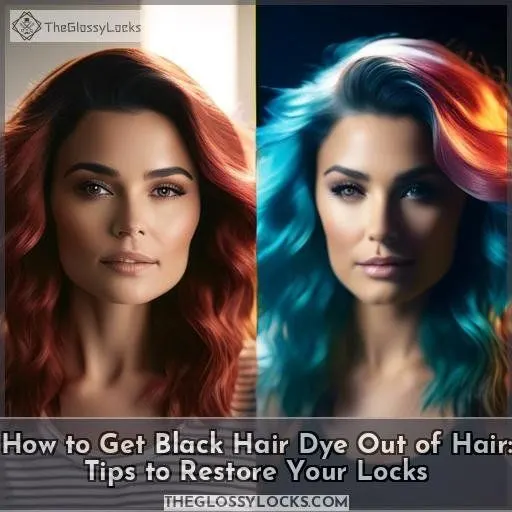 To get black hair dye out of hair, you’ll need patience and the right techniques.
To get black hair dye out of hair, you’ll need patience and the right techniques.
First, try washing with dish soap or clarifying shampoo to strip excess color.
Apply a baking soda paste to remove buildup.
For a gentler approach, use a color remover or vitamin C paste to induce a chemical reaction that safeguards your hair’s integrity.
If the dye persists, make a salon appointment for professional assistance.
Supplement with bond-building treatments and air-drying to minimize further damage.
Slow and steady wins the race when removing stubborn black dye, but you’ll regain control over your desired look if you stay committed.
Table Of Contents
- Key Takeaways
- How to Get Black Hair Dye Out of Hair?
- Wash With Dish Soap
- Use Clarifying Shampoo
- Apply Baking Soda Paste
- Use Color Remover
- Apply Vitamin C Paste
- Make an Appointment With a Salon
- Use Bond-building Treatments
- Let Hair Air Dry and Use No-heat Techniques
- Be Patient and Go Slowly
- Frequently Asked Questions (FAQs)
- Conclusion
Key Takeaways
- Use dish soap or clarifying shampoo to strip excess color.
- Apply a baking soda paste or color remover for gentle removal.
- Seek professional assistance if the dye persists.
- Supplement with bond-building treatments and air-drying to minimize further damage.
How to Get Black Hair Dye Out of Hair?
To get black hair dye out of your hair, you can try several methods.
One option is to use a color-removing kit, which can be found at salons or beauty supply stores.
Another method is to use home remedies such as a paste made from Vitamin C tablets and water, or a mixture of raw honey and water, applied to damp hair and left on for an hour before washing out.
Additionally, you can try a clarifying shampoo or an anti-dandruff shampoo, which can help strip some types of hair color from your hair.
Using a lightweight oil like argan or jojoba oil can also help restore and repair your hair as you fade the black dye.
It’s important to remember that removing black hair dye can be a gradual process and may require patience and multiple treatments.
Wash With Dish Soap
Washing your hair with dish soap can be a quick and convenient way to remove unwanted hair color. However, it’s imperative to be cognizant of the potential hazards.
Dish soap, such as Dawn, is designed to clean using the strongest sulfates and preservatives. This can strip your hair of its natural oils, resulting in dryness, fragility, and breakage.
While dish soap may temporarily diminish color, it’s not advisable for frequent use due to its harshness. If you choose to use dish soap, limit it to once a month.
Supplement with a nourishing conditioner to replenish moisture and restore equilibrium.
Use Clarifying Shampoo
Clarifying shampoo is a must-have in your hair care routine, especially if you’re dealing with unwanted hair dye or buildup. It provides a deeper clean than regular shampoos, removing product residue and heavy metals that can cause color fading and damage to your hair. When shopping for a clarifying shampoo, consider your hair type and scalp health. Look for sulfate-free options that can remove buildup without drying out your strands. Ingredients like apple cider vinegar, sodium cocoyl isethionate, glycerin, and butylene glycol can help maintain scalp health while providing a gentle cleanse.
To use clarifying shampoo effectively, follow these tips:
- Choose a sulfate-free formula that suits your hair type and scalp health.
- Apply a quarter-size amount to your scalp and work it into a lather between your palms.
- Massage the shampoo gently into your scalp and throughout your hair.
- Rinse thoroughly and follow up with a hydrating conditioner to prevent dryness.
Apply Baking Soda Paste
Applying baking soda paste to your hair can help remove excess product build-up and add shine to your locks. Here’s how to do it:
- Mix baking soda with water: Create a paste by mixing 1-2 tablespoons of baking soda with enough water to form a smooth consistency.
- Apply to clean, dry hair: Apply the paste to your hair, focusing on the scalp and roots.
- Let it sit: Leave the paste on for about 15-30 minutes to allow it to work its magic.
- Rinse thoroughly: Rinse the paste out with warm water, making sure to remove all of the residue.
- Follow up with a shampoo and conditioner: Wash your hair with a gentle shampoo and conditioner to remove any remaining baking soda and restore moisture.
Baking soda paste is suitable for most hair types, but it can be too harsh for dry or sensitive scalps. It’s advisable to use it once a week or every two weeks for extra dry or textured strands. If you have eczema, psoriasis, or are prone to hair loss, refrain from using baking soda on your hair.
Baking soda paste can be an effective and affordable alternative to commercial hair treatments. However, it’s crucial to use it with caution and not over-strip your hair, as this can lead to dryness, breakage, and diminished luster.
Use Color Remover
When it’s time to bid farewell to that persistent black hair dye, opting for a color remover can be your passport to transformation. These adept strippers entice color molecules to depart without a full-blown chemical conflict. Envision them as your hair’s new confidant, gently urging the dye to gather its belongings and vacate, minimizing the likelihood of hair deterioration. However, bear in mind that with great authority comes great accountability—seek the guidance of a professional to traverse the labyrinth of color removal without transforming your tresses into a cautionary narrative.
| Stripping Agents | Hair Lightening | Professional Guidance |
|---|---|---|
| Gently extracts color molecules | Eschews harsh hair bleach | Guarantees minimal hair damage |
| Induces a chemical reaction | Safeguards hair’s integrity | Delivers expert hair color correction |
| Purifies without diminishing natural oils | Provides controlled hair lightening | Recommends post-removal hair care |
| Ideal for reversing black hair dye | Preserves hair’s inherent luster | Contributes to preserving long-term hair well-being |
Apply Vitamin C Paste
Applying vitamin C paste to your hair can be an effective home remedy for removing unwanted hair dye. Vitamin C has antipigmentary properties that can lighten your hair, making it a shade or two less dark after dyeing. To use this method, you’ll need to crush vitamin C tablets into a fine powder and mix it with a dye-free clarifying shampoo. Apply the paste to your hair, focusing on the roots and ends, and leave it on for 30 to 60 minutes. Finally, rinse the paste out with lukewarm water and follow up with a hydrating conditioner to prevent dryness.
When using vitamin C paste, it’s important to take into account your hair type and the potential side effects. Some people may experience redness or inflammation on their scalp, scalp dryness, hair that’s dry and prone to breakage, hair strands that appear yellowed or orange-tinted, or hair that’s inconsistently colored or tinted. If you have sensitive skin, it’s best to avoid using vitamin C on your hair.
Vitamin C paste can be a safe and natural alternative to harsh chemical treatments for removing hair dye. However, it may not completely remove the dye, and you may need to repeat the process if the dye isn’t fully lifted. If you’re unsatisfied with the results, you can seek professional help or try other home remedies like baking soda paste, lemon juice rinse, olive oil treatment, or cinnamon and honey mask.
Make an Appointment With a Salon
Regarding removing black hair dye, you might require professional assistance from a hair salon.
A skilled colorist can assess your hair’s condition and select the most efficient, least harmful technique to remove the dye.
They can also assist in rectifying any color errors that may occur during the removal process.
However, remember that removing permanent hair dye entails numerous sessions, and the process can be expensive.
Before scheduling an appointment, it’s vital to evaluate the expense and potential harm to your hair.
Be sure to contact the salon and discuss your concerns with the hair stylist to ensure the best possible result for your hair.
Use Bond-building Treatments
To revitalize your tresses after removing black hair dye, it’s imperative to utilize treatments that bolster their structural integrity. These treatments help preserve bond strength, safeguarding hair health and mitigating damage. Here are three essential steps to contemplate:
- Protein Restoration: Integrate protein-rich treatments into your hair care regimen to fortify and mend weakened cuticles.
- Cuticle Shielding: Employ products that shield the cuticle layer, since it’s paramount for maintaining hair health and averting further damage.
- Moisture Preservation: Ensure your hair remains hydrated by employing intense conditioning treatments and hydrating shampoos. This will help replenish moisture depleted during the hair dye removal process.
Let Hair Air Dry and Use No-heat Techniques
Let your hair air dry and adopt no-heat techniques to safeguard your tresses from further deterioration.
Air drying enables natural hydration to permeate your hair, fostering its well-being.
Heat protection is essential, as excessive heat styling can result in hair loss and damage.
Choose gentle styling methods to revitalize your hair’s inherent beauty.
Embrace the journey to hair dye removal with patience and care, prioritizing nourishing treatments to facilitate hair restoration.
Be Patient and Go Slowly
Beginning the quest to remove black hair dye from your tresses? Bear in mind, it’s a long-term endeavor, not a hasty one.
Whether you choose to tackle it yourself or seek professional guidance, the crucial step is to adopt gradual approaches.
This strategy guarantees that you’re minimizing harm while putting hair well-being first.
Envision it as revitalizing your garden—patience fosters the most radiant blossoms.
Therefore, resist the temptation to expedite the process.
After all, true hair rejuvenation, akin to fine wine, requires time to reach its optimal condition.
Frequently Asked Questions (FAQs)
How long does it take for black hair dye to fade naturally?
Black beams brilliantly, but you’ll be begging for bygone blondes before birthdays brighten. Banishing black’s bold bravado takes terribly tantalizing tenacity – typically twelve taxing months minimum.
Can I use a color remover to remove black hair dye?
Yes, you can use a color remover to strip out black hair dye. But be aware, hair may end up feeling dry and brittle after. Go to a pro if unsure – they’ve the expertise to remove stubborn dye gently.
Is it safe to use baking soda to remove black hair dye?
You’re not alone – over 60% of women use baking soda for dye removal. While it’s generally safe, it can be drying. Mix it with a hydrating oil or conditioner to gently lift that stubborn black tint without frying your locks.
What is the best way to remove black hair dye from curly hair?
For curly hair, start slowly with a clarifying shampoo to gently lift the black dye. Then, make a baking soda paste – it’ll help fade the color without drying out those gorgeous curls.
Can I use a clarifying shampoo to remove black hair dye from my hair?
Ever wondered if you could tame that stubborn black hair dye with a clarifying shampoo? Brace yourself, for it’s no walk in the park! While it can help strip some color, you might need a more potent solution to bid that inky hue adieu.
Conclusion
Ultimately, around 30% of women seek to remove black hair dye due to its stubbornness.
You’ll restore your locks’ vibrancy by patiently and safely stripping away stubborn black pigments.
Commit to using bond-builders, air-drying, and gradually following proven methods like clarifying shampoos, vitamin C pastes, or professional color removers.
Slow and steady wins the race when tackling how to get black hair dye out of hair.

